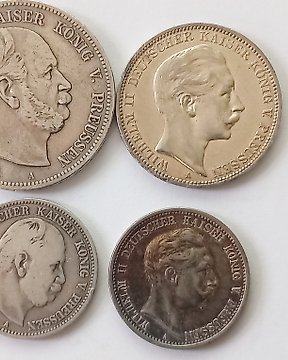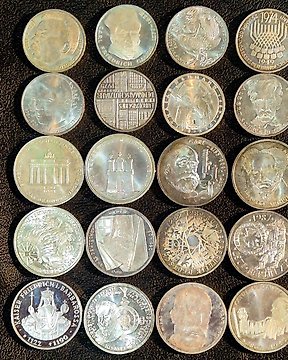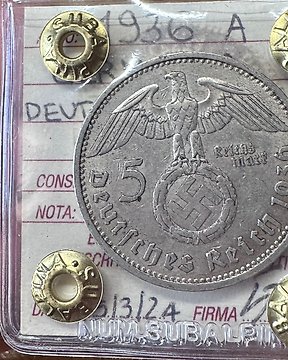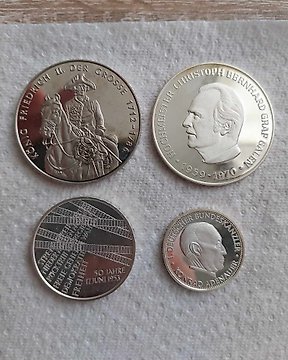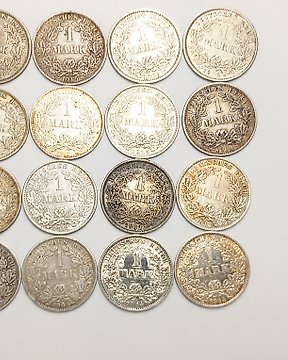Germany, Third Reich. High quality type collection, 1 Pfennig/5 Mark 1936-1944 11 coins incl. 3x silver (No Reserve Price)
No. 83202505

Germany, Third Reich. High quality type collection, 1 Pfennig/5 Mark 1936-1944 11 coins incl. 3x silver (No Reserve Price)
No. 83202505

Germany, Third Reich. High quality type collection, 1 Pfennig/5 Mark 1936-1944 11 coins incl. 3x silver (No Reserve Price)
Attractive lot with 11 different type coins from Nazi Germany. All in high quality and including silver coins.
Note: Following our policy concerning explicit content, the swastikas on these coins are covered. The original images are available, please feel free to reach out to Catawiki, the images can be provided upon request. Thank you for your understanding.
Please have a look at our other Catawiki auction lots for more coin collections. and/or add us to your favourites to find our future auction lots easily.
Bid with confidence. AG-Worldcoins, over 3000 lots sold on Catawiki. High feedback score.
Please evaluate this lot with reference to the images provided.
Will be sent via registered mail.
I charge only 1x shipping costs when you buy multiple lots in the same auction.
You are welcome to bid on my other items:
https://veiling.catawiki.nl/aanbod/hamaca
extra info:
MINT MARKS
A - Berlin
B - Vienna, 1938-1944
D - Munich
E - Muldenhutten
F - Stuttgart
G - Karlsruhe
J - Hamburg
1933-1945
A wide range of factors, such as humiliation of
defeat, economic depression, poverty, and a pervasive feeling of discontent aided Hitler in his climb to power. After the unsuccessful Putsch (uprising against the Bavarian Government) in 1923, Hitler was imprisoned in Landsberg Fortress. While imprisoned Hitler dictated his book “Mein Kampf” which became the cornerstone of Nazism espousing Hitler’s irrational ideology and the manipulation of power without moral constraint as the basis of strategy.
Master propagandist Josef Goebbels tried to attract the sympathetic attention of the German public. The usual tactic was to have Hitler promise all things to all people provided that they in turn would pledge to him their complete faith and obedience.
Once in power, coercion was used to elicit the appearance of unanimous endorsement. Public works and military rearmament helped overcome the depression. It took the Nazis only about two years to consolidate their system politically. The combined terrorism of the storm troops and the police forces, including the Gestapo, stifled potential opposition. By 1935, Nazi affiliated organizations controlled all German cultural, professional, and economic fields, assuring strict compliance with the party line.
With the passage of the Nurnberg Laws in 1935, the more ominous aspects of Nazi anti-Semitism came to light. Jews were deprived of their citizenship and forbidden to marry non- Jews. This was followed by confiscation of property, eventually culminating in the mass deportation to concentration and death camps.
By 1936, unemployment was virtually eliminated and economic production was up to 1929 levels. All sources of information were under the control of Josef Goebbels, while all police power was in the hands of Heinrich Himmler. Himmler’s Gestapo would silence Germans who were not convinced by Goebbel’s propaganda machine. Usually the implied threat was enough. The majority of Germans did not suffer any ill effects at first and national pride stirred once again.
Hitler’s audacity in foreign affairs met with success due to the trend of appeasement by the western powers. First, Germany withdrew from the League of Nations and the World Disarmament Council. In 1935, the Saar voted to return to Germany and Hitler renounced the reviled 1921 peace treaty and related pacts. In 1936, German forces reoccupied the Rhineland. In 1938, Austria was annexed and at the Munich Conference, which excluded Czechoslovakia, Great Britain and France agreed that the Sudetenland was to become German territory. In 1939, Slovakia became an independent Nazi Puppet State and the “Protectorate” of Bohemia and Moravia was established. Next came the German-Soviet non-aggression pact, which secretly divided up Poland between the two totalitarian powers. Great Britain and France finally declared war when Poland was invaded. The years of 1939-1942 were a period of impressive victories for Germany’s well-trained and equipped forces. However, when Hitler expanded his war beyond Western Europe by invading Africa and Russia and declaring war on the U.S.A., it started the chain of events, which would culminate in the total and final German defeat on May 8, 1945, VE Day, ending the European theater of the Second World War and The Third Reich.
You might also like
- 16+
This object was featured in
How to buy on Catawiki
1. Discover something special
2. Place the top bid
3. Make a secure payment

